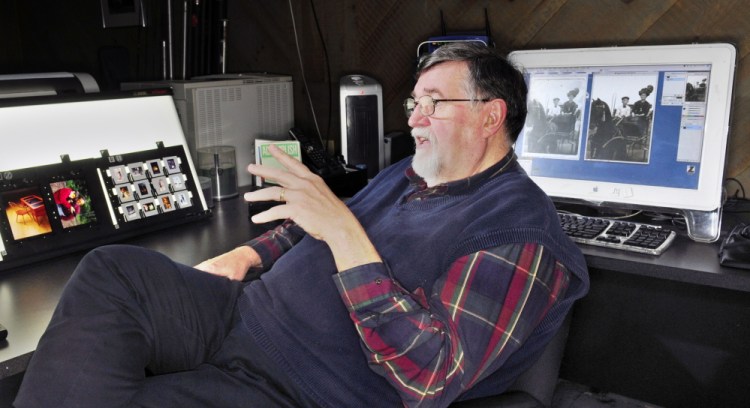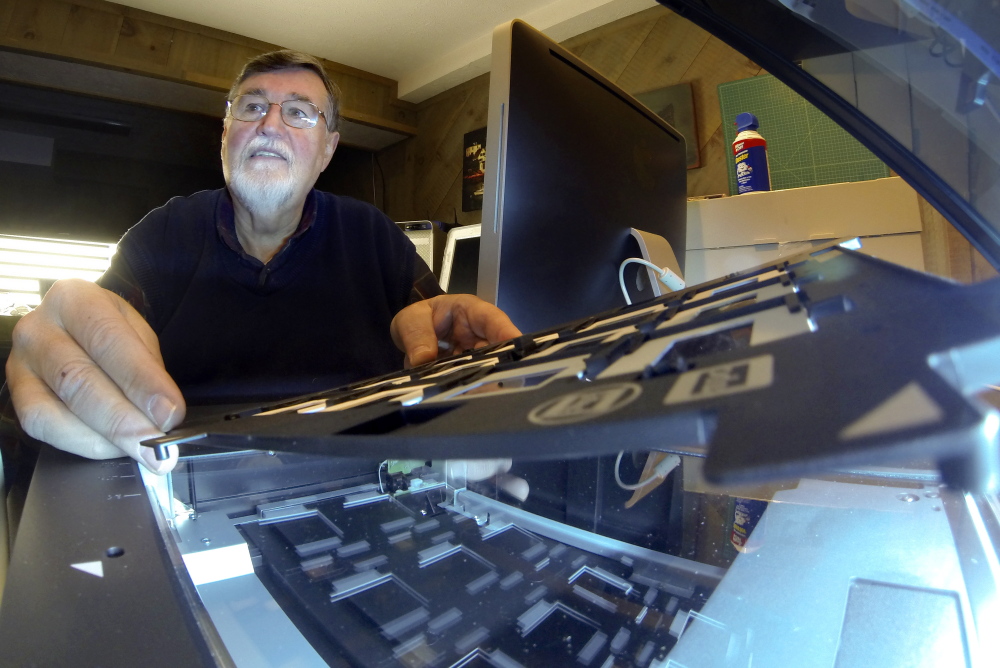The boy wearing a white sweater, blue jeans and white sneakers is sitting on a small rock. He is smiling intently at the autumn-colored leaf he holds gently in his hand. He’s young, somewhere around 2, and displays a palpable wonder and innocence. The boy’s future lies ahead; but this moment, even now, is hauntingly beautiful.
Ron Simons took the picture more than 30 years ago. He was reminded of that recently when the boy’s grandmother returned to Simons’ Readfield photography studio desperate to have the picture, badly eroded by time and elements, restored to its original quality. The boy, Simons said, left behind the idyllic life depicted in the photo and died tragically young.
Simons took the photo, the tangible link to a happier time, and went to work making it more closely match the reality of that day. Scanning the photo into his computer, he touched and corrected the image until the young boy with blond hair emerged brilliantly from within.
“I knew the colors because I did the photograph,” Simons said.
When the photo was ready, he called the boy’s grandmother to come and take a look. Simons displayed the photo on a large high-definition television in his studio.
“I put this up and the tears came,” Simons said. “She gave me hug, I thought she was going to break my back. I had brought something back that meant so much to her.”
Simons, 68, has made his living capturing people, places and things on film for the last 36 years, but over the past decade the face of his business has changed as he suffered through cancer and a downturn in business that lasted for more than two years.
Now, content to take photography jobs as they come and spend as much time as possible with his family, Simons has launched a service that allows people with photo negatives and slides to restore and preserve in perpetuity their most treasured images.
“I decided that I could sit down and be angry or I could kind of do the, ‘You get lemons, you make lemonade,’ which is where the scanning came in,” Simons said.
A LIFELONG PASSION
Simons discovered his passion for photography in the early 1970s when his boss sold him a camera for $15.
“It was like heroin,” he said.
He devoured photography books and shot countless rolls of film. Within a couple of years he had convinced his wife, Susan Simons, that he needed a $150 equipment upgrade. Simons soon hocked his guitar to buy better and more equipment. He promised himself that he would earn enough from photography to buy the guitar back. His work eventually would pay for several guitars as he landed a host of large commercial clients including Saab Aircraft, Wearguard and Sears. The biggest client, however, proved to be L.L. Bean, which, from 1982 to 2006, hired Simons to work as one of only two primary photographers. Simons’ studio is dotted with pictures of fly rods, fishermen and fresh-faced outdoors enthusiasts that he took for the famed L.L. Bean catalog.
That all changed in 2006. Fuel prices went up. The number of people hiring photographers went down.
“The economy went to hell,” Simons said. “My business from that point went down 50 percent. People were nervous. I don’t blame anybody, because if I had a choice between buying senior portraits or a half of tank of oil, I’d take the oil.”
That same year Ron Simons developed prostate cancer. He underwent surgery and continued to take the work that came while undergoing chemotherapy. The cancer is now in remission.
Things only got worse over the next few years. A pair of elderly family members, suffering health problems, moved in with the Simonses, requiring much of their attention. There was little time or money to spend on advertising in hopes of drumming up more business.
The collapsing housing market hit home for the Simonses, who had built a new house nearby and put their existing house on the market. They built the new house at a time when houses in Maine were selling quickly and for a lot of money.
“The market was really strong and then, all of a sudden, it was gone,” Simons said. “We decided to sell the new house.”
The waves of misfortune and difficulty took a toll. Simons said he was essentially out of business from 2006 to 2008. There were, he said, a number of sleepless nights. “It was like someone got a baseball bat and kept hitting me over the head with it,” Simons said. “You start thinking, ‘What did I do wrong?’ That gets to you after a while.”
DIGITAL PROLIFERATION
Senior portraits always had provided the bulk of Simons summer work, but after two-plus seasons with almost no clients, that business all but disappeared for good even as the economy started to spring back to life.
“You go from No. 1 to number who?” Simons said.
Further complicating matters is the proliferation of cheap digital cameras. Simons’ Photographic about 20 years ago became one of the first studios in the state to use a digital camera. He paid almost $30,000 for his first. Simons, who used the camera for commercial work, saved $17,000 in film and processing fees the first year. Digital photography also allowed Simons greater flexibility and creativity.
But the digital age also ushered in unprecedented challenges. A digital camera now can be had for a few hundred dollars, putting it within reach of do-it-yourself parents, willing to take their own family portraits, and upstart photographers willing to take portraits for very little money.
“The whole digital thing is a double-edged sword,” Simons said. “Inexpensive digital cameras have put a lot of studios out of business.”
However, Simons said, nobody has ever hired his camera. It is Simons’ eye and talent that they seek.
“You can give me a drill, a drill bit and a knife, and that doesn’t make me a surgeon,” Simons said. “They are tools. A camera is a tool.”
Commercial work slowly trickled back in over the next several years beginning in 2008, but it wasn’t until recently that Susan Simons hit upon the idea of expanding the company’s offerings. Ron Simons said he had for 20 years provided scanning services for commercial clients. Susan Simons suggested offering the same service to everyone.
“I was so busy doing that the idea never came,” Simons said.
Simons is relying on the countless individuals, families, companies and institutions that have old or damaged photographs, or boxes of film negatives, that they would like to protect by scanning them into a computer to make a digital copy. Simons recently converted more than 100 negatives of a client’s wedding more than 15 years ago. On his computer monitor last week was a picture, apparently taken in the 1900s, that had been converted from an original that was stained, aged and wrinkled, into a quality that is, in all likelihood, better than new. The photo is one of the only existing images of Simons’ client’s grandfather.
“I don’t expect a suitcase of photos, but ones they treasure, they can have them and not worry about losing them,” Simons said.
And, like portraits, Simons clients are hiring his eye and talent much more than his computer equipment.
“You’ve got to get the color right,” he said. “You have to have the knowledge.”
The Simons are again trying to sell their home. When they do, they will move to a smaller place. They will rent so Ron Simons doesn’t have to worry about mowing the lawn. Taking photo assignments as they come, restoring treasured pictures from the past, and spending time with his family fit Simons’ new life quite well. Simons said the scanning service will never restore business to what it was before, and he’s good with that.
“I don’t want to work seven days a week anymore,” he said. “I look at this as something that I can do that I enjoy. I enjoy this probably just as much as I do taking portraits.”
Craig Crosby — 621-5642
Twitter: @CraigCrosby4
Send questions/comments to the editors.




Success. Please wait for the page to reload. If the page does not reload within 5 seconds, please refresh the page.
Enter your email and password to access comments.
Hi, to comment on stories you must . This profile is in addition to your subscription and website login.
Already have a commenting profile? .
Invalid username/password.
Please check your email to confirm and complete your registration.
Only subscribers are eligible to post comments. Please subscribe or login first for digital access. Here’s why.
Use the form below to reset your password. When you've submitted your account email, we will send an email with a reset code.